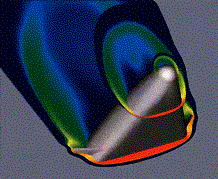

Aerothermodynamics Facilities
NASA Langley Research Center
The Aerothermodynamic Facilities Complex is a collection of four hypersonic wind tunnels utilized for basic fundamental flow physics research, aerodynamic performance measurements, and aeroheating assessment, optimization, and benchmarking of advanced space transportation vehicles.
Collectively, they provide a wide range of Mach number, unit Reynolds number, and normal shock density ratio (see table below. The AFC facilities are relatively small and economical to operate, hence ideally suited for fast-paced aerodynamic performance and aeroheating studies aimed at screening, assessing, optimizing, and bench-marking (when combined with computational fluid dynamics) advanced aerospace vehicle concepts and basic fundamental flow physics research.
The AFC facilities were designed and constructed in the late 1950's and early 1960's. The AFC has contributed to most major hypersonic vehicle programs including the Apollo, Viking, Space Shuttle Orbiter, National Aero-Space Plane, Pegasus XL, DC-X/Vertical Takeoff and Landing Vehicle, X-33/Advanced Technology Demonstrator, X-34/Small Reusable Booster, X-38/Experimental Crew Return Vehicle, Kistler/Small Payload to Orbit Vehicle, Reusable Launch Vehicle, and X-43.
With the renewed interest in planetary and space exploration, the AFC has also contributed in this arena to the development of the Mars Microprobe, Stardust Sample Return Capsule, and Genesis.
15-Inch Mach 6 High Temperature Tunnel
|
20-Inch Mach 6 CF4 Tunnel
|
||||||||||||||||||||||||||||||||||||
20-Inch Mach 6 Tunnel
|
31-Inch Mach 10 Tunnel
|

Computational Fluid Dynamic Results of Flowfield Over X-33 Vehicle

Surface Heating Image of X-34 Acquired with Thermographic Phosphor Technique
All AFC facilities have compatible, stand-alone data acquisition systems. The heart of the system is a 128 or 256 channel, 16-bit, 50 or 100kHz throughput rate, amplifier per channel, analog-to-digital NEFF System 620/Series 600. Acquisition and reduction computers are Hewlett Packard 9000 series 745i systems. Macintosh computers are available in all control rooms to aid in the post-run plotting and analysis data. Customer supplied computers can be networked to the data reduction system if desired.
Langley?s LHB 1710.15 Wind Tunnel Model System Criteria is the guideline for model design and fabrication. Model installation and any exceptions to this document must have the approval of the 0.3-M TCT Safety Head on a case-by-case basis to assure personnel and tunnel hardware are not exposed to risk.
